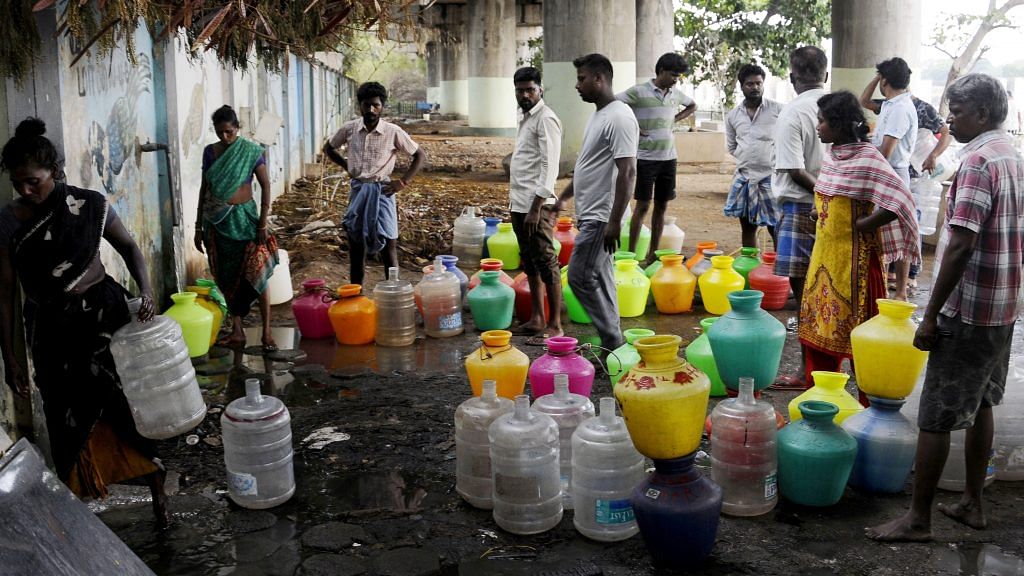Bengaluru: People of Chennai begin queuing up as early as 3 am with plastic pots in hand, just to get a few litres of water from a tanker to survive the day. Fights are common and turn uglier as the tankers empty.
Taps in the southern metropolis began to run dry over 200 days ago, but the state government has been unable to meet the demand for water. The four reservoirs that quench Chennai’s thirst — Poondi, Cholavaram, Chembarambakkam and Red Hills — have hit their dead storage level, which means that the water has dropped below the lowest outlet.
The coastal city’s three water desalination plants are only 80 per cent efficient, and Chennai Metro Water says it can only supply 500-525 million litres a day (MLD) when the demand is close to 1,300 MLD.
There are plans now to transport water from nearby areas like Jolarpettai through trains, but they can’t come to fruition soon enough for the citizens.
The central government had anticipated the delay in rains, issuing a ‘drought advisory’ last month to Maharashtra, Gujarat, Karnataka, Andhra Pradesh, Telangana and Tamil Nadu, directing them to utilise their water resources judiciously.
But the Madras High Court has had to come down heavily on the Tamil Nadu government for mismanaging the situation and not taking adequate measures to address the water crisis. It has sought a detailed report on how many lakes have been taken up for desilting and how many encroachments on water bodies have been cleared.
The state is now tapping water released from desalination plants as well as that filled in mines and quarries to quench people’s thirst.
People’s woes
Saraswati, who works as a domestic help, lives in the Triplicane area, where piped water supply has been shut down for a month now.
“The water from the taps is mixed with sewage and we cannot do anything with it, not even wash clothes. I have to stand in line from 4 am every day, waiting for the water tanker, so that my family has water to drink at least,” she says.
The only beneficiaries in this crisis are tanker suppliers, who charge between Rs 3,000 to 5,000 for 1,000 litres. But they too have begun complaining about the water shortage — borewells are also dry due to incessant pumping.
So severe is the crisis that companies have asked employees to work from home, schools are shutting after half a day’s work, and some small and medium-sized restaurants have downed shutters. Some are even serving food in banana leaves and reducing the quantity of sambar, which needs a lot of water to make.
Parthiban, a local restaurant owner, says his employees would earlier serve water to guests as soon as they sat down. “Now, we ask them if they want water, only then we serve them,” he says.
Chennai did see some showers, but that has not mitigated the problem. The city is staring at its own ‘Day Zero’, like Cape Town in South Africa did in 2017-18.
Tamil Nadu is keeping its fingers crossed, now that the Cauvery Water Management Authority (CWMA) has ordered Karnataka to release 9.19 thousand million cubic feet (TMC ft) of water immediately, and another 31.24 TMC ft in July. But Karnataka has its own problems, leading the CWMA to say: “Only if there is water, please release water.”
Political turn
Naturally, the issue has taken a political turn. The opposition DMK has warned of a state-wide stir if the AIADMK government doesn’t find a solution.
DMK workers Monday launched protests and threatened a jail bharoti (fill the jails) stir if immediate action is not taken. Party chief M.K. Stalin raised a pot and asked “Kodam inge, kudineer enge?” (Here is the pot, where is the water?)
The neighbouring state of Kerala offered to send 20 lakh litres of water by train, but Tamil Nadu CM Edappadi Palaniswami, while thanking his counterpart Pinarayi Vijayan, said extending a one-time offer of water would not solve the problem. Instead, he made a political point by urging Kerala to keep the Mullaperiyar reservoir full, so that it can help Tamil Nadu in such a crisis. The two states have been at loggerheads for years on the issue of sharing the waters of the Periyar river.
Palaniswami has also blamed the media for “unnecessary hype”, and has urged it not to “create an illusion of a severe water crisis”. His government has also assured the Madras High Court that all necessary steps are being taken to ensure that people get drinking water in their homes.
But amateur weatherman and blogger K. Srikanth says there seems to be no immediate solution to the problem for the next three months. The rains will not help in replenishing the reservoirs, but could just about bring the water table up to a good enough level.
“The lakes will be filled only if we get a good shower from the north-east monsoon, which will hit Tamil Nadu only in October. Until then, Chennai has to get water from other sources,” he said.
Is there a long-term fix?
Water experts such as Himanshu Thakkar of the South Asia Network on Dams, Rivers and People say India needs to urgently draft an urban water policy.
“We look for easy solutions. We will not harvest rainwater, not recharge the groundwater, not protect the water bodies, not recycle sewage water. We fail to understand that the urban water footprint has been growing in leaps and bounds and we need to address the problem,” Thakkar told ThePrint.
“Concretisation and destruction of water bodies is one of the major causes for such situations. The real issue is to understand that groundwater is India’s lifeline, and recharging groundwater and regulate it for effective distribution need to be prioritised.”
Also read: Patchwork laws can’t solve India’s water crisis, Modi govt must push these 2 key bills now
